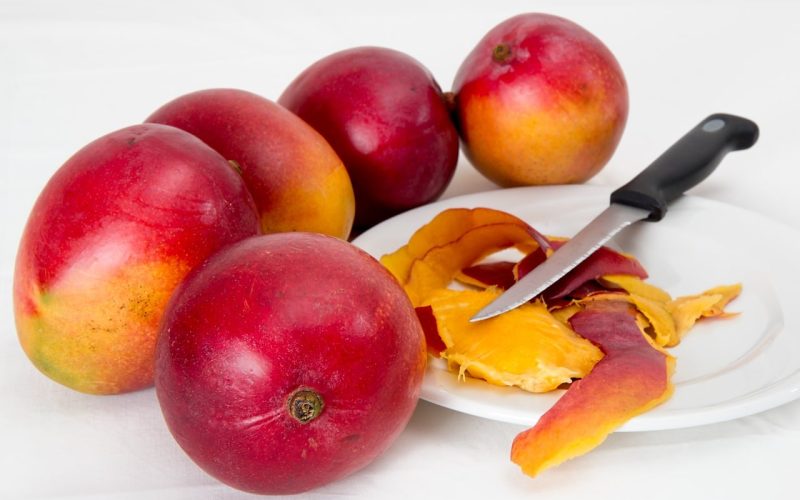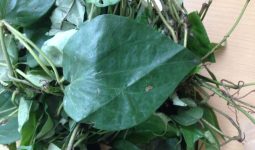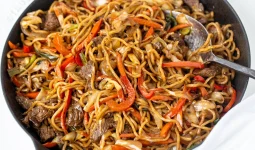You might not think much about the seeds as you bite a fruit. However, there are some fruits with seeds.
Drupes are the name for fruits with big seeds. Fruits are an integral element of our lives and the entire food chain.
Fruits are categorized according to size, shape, flavor, and shelf life.
Fruits with big seeds include cherimoya, dates, and mango. Each of these fruit varieties has unique traits.
Our post will introduce you to fruits with bid seeds and discuss their advantages. Additionally, we’ll advise you on how to include these fruits in your diet.
So sit back, unwind, and get ready to discover some incredible fruits with large seeds.
1. Pomegranate

The pomegranate fruit is starting our list of fruits with big seeds. It is a berry with a rounded hexagonal form with a diameter between 5 and 12 cm.
Pomegranates often have thick reddish skin, although they can also have yellow, purple, or up to 600 seeds.
Arils, the plant’s enormous, juicy, crunchy edible seeds, are crowded into a white inner body. It is viewed as a fruit with large seeds.
Pomegranates are low in calories and fat and high in fiber, vitamins, and minerals.
These fruits with big seeds benefits include antioxidants, heart health, urinary health, exercise endurance, and other things.
Antioxidants are abundant in this sour fruit and can help shield your skin from deterioration and aging.
It’s also high in fiber, so if you’re looking for a snack that will make you feel full for a while, this is a fantastic option.
2. Jackfruit
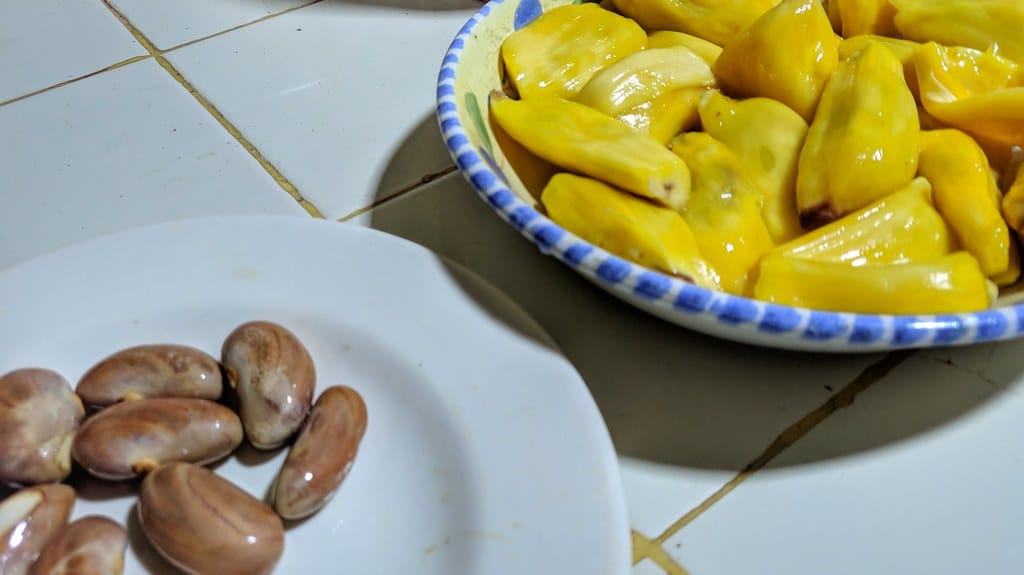
Jackfruit is also one of the fruits with big seeds. The largest edible fruit in the world is the jackfruit.
Ripe fruit can grow to a maximum length of 90 cm and weigh between 2 kg and 36 kg.
A single fruit will frequently contain between 100 and 500 seeds or 8 and 15% of the weight of the fruit.
The seeds are appropriately categorized as having large seeds because they are large, measuring 1-2 cm in diameter and 2-4 cm in length.
The enormous, nutrient-rich jackfruit fruit can weigh up to 100 pounds.
The jackfruit is a fantastic snack or supplement to your diet because it is a high source of fiber, potassium, and vitamin C.
The fruits with big seeds are also a fantastic source of protein.
3. Avocado

The pear-shaped fruit has a huge center seed that is 5-6.4 cm (2-2+12 in) long, weighs between 100 and 1,000 g (3+12 and 35+12 oz), and is typically 7-20 cm (3-8 in) long.
Due to the great size of the avocado fruit, the size of the seeds can easily be mistaken for that of a little fruit.
This fruit is loaded with nutrients and a wonderful source of fiber, vitamins C and E, and good fats.
Additionally, these fruits with big seeds are a rich source of antioxidants to help maintain healthy skin.
The domestic variety fruit has buttery-smooth, golden-green flesh when it is fully grown.
Depending on the cultivar, avocados can have a pear, egg, or spherical form and have skin that is green, brown, or black in color.
Never neglect the avocado while looking for large-seeded fruits in the future.
4. Peaches
Peaches have cousins in the fruits of apricots, cherries, almonds, and plums.
They are classified as a fruit with giant seeds (drupes or stone fruit) because their flesh surrounds a shell that contains large seeds.
The solitary, enormous seed is enclosed in a husk that resembles wood and is reddish-brown in color, oval in form, and 1.3-2 cm long.
Peaches are stone fruits (drupe) with cherries, plums, and apricots. They can be eaten on their own or in many various cuisine combinations.
Peaches are nourishing and potentially have several health benefits, including reducing allergy symptoms, producing smoother skin, and enhancing digestion.
Peaches are an excellent source of plant nutrients, including vitamins and minerals.
5. Mango
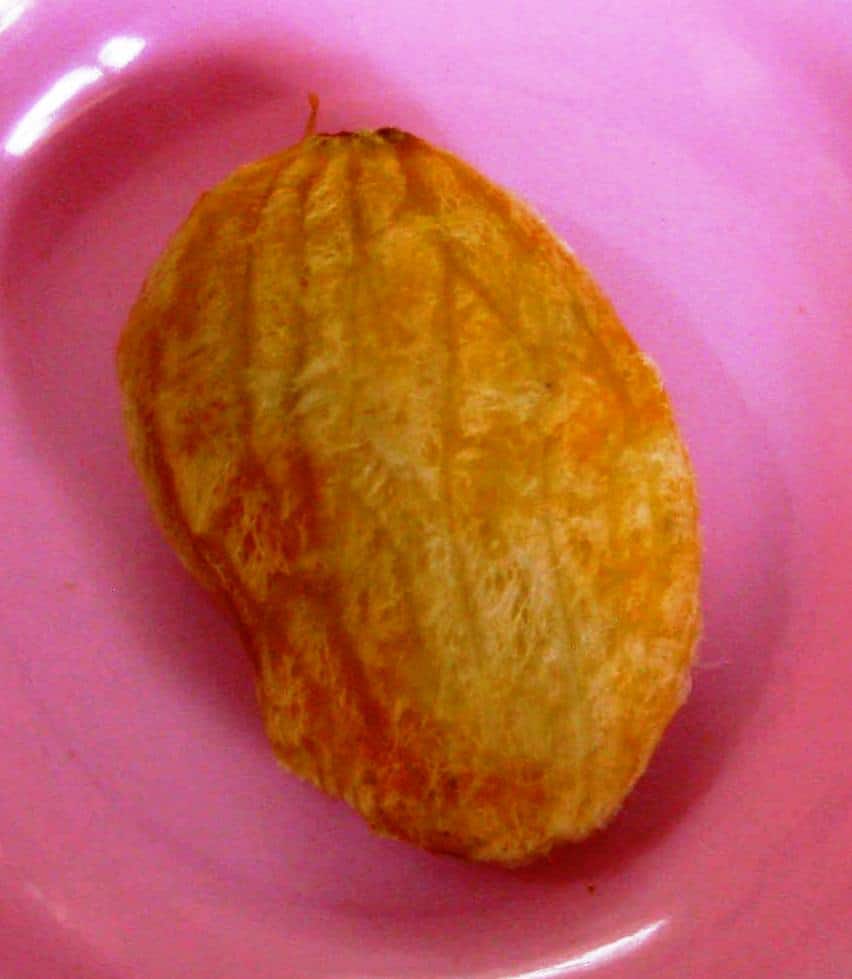
Mangos are stone fruits or drupes, which means they are fruits with big seeds. Mango seeds can be large and weighty.
Depending on the variety, a mango seed’s flat, rectangular surface can be hairy or fibrous.
A thin, 1-2 mm thick lining is present inside the seed coat, enclosing a single embryo that is 4–7 cm long, 3–4 cm wide, and 1 cm thick.
In a mango seed, the kernel is encased in a hard shell. There are numerous varieties of mango.
They differ in seed size, color, shape, and flavor. Mangoes’ inner meat is primarily golden yellow, even though their skin can be green, red, yellow, or orange.
Mangoes support a healthy immune system and may help combat chronic and inflammatory diseases since they are a high source of fiber and antioxidants, including vitamin C.
They make up a good portion of a diet that is generally nutritious and contains nutrients that support the health of the skin and eyes.
6. Coconut

The only plant species in the Cocos genus is the coconut tree (Cocos ).
The second-largest seed in the world is found in the coconut plant. You can refer to the entire plant, the seed, or the fruit as a coconut.
The most common traditional uses of coconut fruits are in food and cosmetics.
The exocarp, mesocarp, and endocarp are the three layers of coconut seed.
The husk of the coconut is made up of two exterior layers, and the mesocarp is made up of many fibers known as coir, which are employed for both modern and ancient uses.
When the husk is removed, the seed’s germination pores are visible.
7. Almond Fruit
The almond fruit is next on our list of fruits with big seeds. 80 percent of almond seeds fall between 21.09 and 21.29 mm in length, 80 percent between 10.25 and 12.43 mm in width, and 80 percent between 6.28 and 6.47 mm in thickness. Yes, that is a sizable seed. True, it is.
The deciduous almond tree has a strong dormancy. 4% of almonds are water, 21% are protein, 22% are carbohydrates, and 50% are fat (table).
Almonds contain 2,420 kilojoules (579 kilocalories) of nutritional energy per 100 grams (3+12 ounces) of a reference weight.
The nutritional value of almonds is high (Table), and they contain significant amounts of the essential minerals calcium, copper, iron, magnesium, manganese, phosphorus, and zinc (20% or more of the Daily Value, DV). Almonds are tasty and very nutrient-dense.
8. African Star Apple

When the moisture level rose from 3.00 to 18.03 percent, the dimensions of the wide variety of the African star apple seed ranged from 27.61 to 28.09 mm, 15.14 to 15.84 mm, and 8.52 to 8.86 mm, respectively.
The natural fruit known as the African star apple is native to tropical African countries like Nigeria and Uganda.
It contains numerous nutrients that are beneficial to your health.
Its scientific name is Chrysophyllum albidum, belonging to the Sapotaceae family.
African star apple trees offer wonderful yellow fruit from December through March.
9. Idiot Fruit
The idiot fruit is ending our list of fruits with big seeds. It measures 3.1 inches in diameter and 8 centimeters in diameter, weighing roughly 7.9 ounces (225 grams).
The seeds of this tree are truly an oddity in themselves, most of them about the size of an adult human’s hand.
It has been observed that the seedlings from these gigantic seeds grow to a height of 80 cm to 1 m.
The Australian Idiospermum species of the Spicebush Family (Calycanthaceae) is where the idiot fruit is categorized.
Even though its seeds are quite deadly, it is recognized as a fruit with large seeds.
One of the most remarkable features of the Idiot Fruit is that it is exclusive to this planet.




